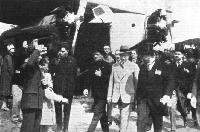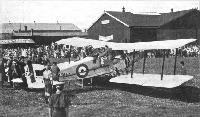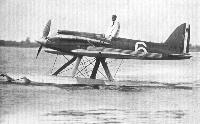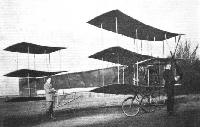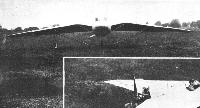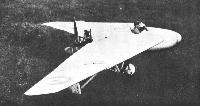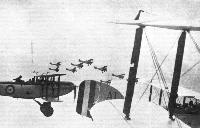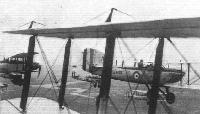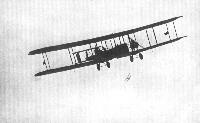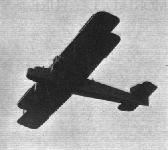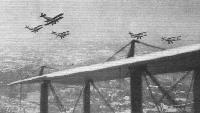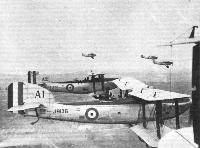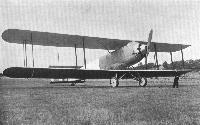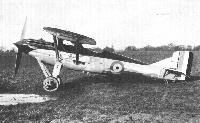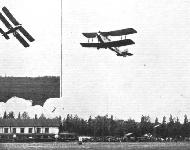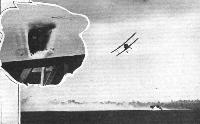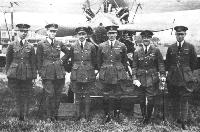Фотографии
-
DE HAVILLAND D.H.9A: Day Bomber, with "Liberty" Engine.
Самолёты на фотографии: De Havilland D.H.9A - Великобритания - 1918
-
THE BIRMINGHAM "SKY-TERRIERS": No. 605 County of Warwick (Bombing) Squadron, take off to bomb the "Derelict Fort" (no natives, by request!).
Самолёты на фотографии: De Havilland D.H.9A - Великобритания - 1918
-
Armstrong-Siddeley Engines in Italy: Sig. Mussolini (second from right, in silk hat) inspecting the triple-engined (Armstrong-Siddeley "Lynx") Fokker monoplane employed on the Munich - Milan air line. Next to the Duce is Gen. de Pinedo, while behind him, on the extreme right, is Sig. Balbo, Italian Under-Secretary for Air. Note the young lady just about to give the Fascist salute.
Самолёты на фотографии: Fokker F.VII / C-2 / F.XIV - Нидерланды - 1924
-
BRISTOL "BULLDOG": Single-seater Fighter, with Bristol "Jupiter" Engine.
Самолёты на фотографии: Bristol Bulldog - Великобритания - 1927
-
CAMBRIDGE UNIVERSITY AIR SQUADRON AT OLD SARUM: The afternoon parade. Three Bristol Fighters and six Avro Lynx.
Самолёты на фотографии: Avro Avro 504N - Великобритания - 1920Bristol F.2A/F.2B Fighter - Великобритания - 1916
-
Регистрационный номер: J8430 THE PRINCE OF WALES FLIES: Our picture shows His Royal Highness entering his Bristol Fighter (fitted with Handley Page Slots) - which has been set aside for his special use - at Mousehold Aerodrome, Norwich, prior to his flight to Northolt, on May 30. Before his departure, the Prince inspected the Norfolk and Norwich Aero Club, which has its home at this Aerodrome.
This dual controlled Bristol F.2B Fighter Mk III was furnished as the special personal transport for HRH the Prince of Wales.Самолёты на фотографии: Bristol F.2A/F.2B Fighter - Великобритания - 1916
-
PARACHUTING FOR A LARK: Miss June invented a new sport at the Midland Pageant. In descending from an Avro with her "Guardian Angel" parachute, as shown above, she caught a lark in the "cup" of the parachute.
Самолёты на фотографии: Avro Avro 504 - Великобритания - 1913
-
Регистрационный номер: N219 SUPERMARINE-NAPIER S.5: Racing Monoplane (Schneider Trophy Winner), with Napier Racing Engine.
Самолёты на фотографии: Supermarine S.5 / S.6 - Великобритания - 1927
-
Pioneer Work! This early Avro triplane had variable incidence wings, but in almost every other respect all the features of a modern tractor aeroplane were incorporated
Самолёты на фотографии: Avro Triplane I - III - Великобритания - 1909
-
Регистрационный номер: G-EAIN, G-EBUR, G-EBXT THE MIDLAND AIR PAGEANT: A portion of the machine park, and some of the crowd at Castle Bromwich Aerodrome.
Самолёты на фотографии: De Havilland Moth / D.H.60 - Великобритания - 1925Sopwith Grasshopper - Великобритания - 1920
-
THE MIDLAND AERO CLUB'S NEW "MOTH": Three members of the Club (l. to r.), Flight-Lieut. T. Rose (Instructor), Mr. W. J. Halland, and Mr. W. F. Sutcliffe, standing in front of the new D.H. "Moth X," "Wulfrun," which was presented to the Club by Messrs. J. D. and N. B. Graham of Wolverhampton.
Самолёты на фотографии: De Havilland Moth / D.H.60 - Великобритания - 1925
-
Регистрационный номер: G-EBPT, G-EBWI The Midland Air Pageant: Event 1, the finish of the Midland Inter-Club Handicap. F. L. Turnbull, on the Newcastle Club "Moth," 'PT, crosses the line first, with Norman Jones, on the London Club "Moth," 'WI, second.
Самолёты на фотографии: De Havilland Moth / D.H.60 - Великобритания - 1925
-
Регистрационный номер: J7938 BOULTON & PAUL "SIDESTRAND": Medium Range Bomber, with two Bristol "Jupiter" Engines.
Самолёты на фотографии: Boulton Paul Sidestrand / P.29 - Великобритания - 1926
-
Регистрационный номер: J8459 BOULTON & PAUL "PARTRIDGE": Single-Seater Fighter, with Bristol "Jupiter" Engine.
Самолёты на фотографии: Boulton Paul Partridge / P.33 - Великобритания - 1928
-
WESTLAND-HILL "PTERODACTYL 1A": Experimental tailless two-seater, with Armstrong-Siddeley "Genet" Engine.
Самолёты на фотографии: Westland-Hill Pterodactyl - Великобритания - 1925
-
Регистрационный номер: J9251 Capt., later Prof. Geoffrey T. R. Hill's Westland Pterodactyl lb, first flown in mid-June 1928, was, perhaps, the most visually pleasing of this series of tailless aircraft produced by Westland under his design leadership. A former chief test pilot for Handley Page, the Captain had devoted much of his efforts during the 1921 to 1924 period attempting to devise a safe, stall-proof aircraft. Aided by a 3-year research scholarship and subsequent support from the Royal Aircraft Establishment, Hill brought forth his first tailless glider at the end of 1924 and, built with the aid of RAE, a much improved powered version in the autumn of 1925. Hill joined Westland during the spring of 1926, where he embarked on the design of the machine shown here, which carried the Air Ministry serial J9251. This machine in its Mk. lb form was powered by a 70hp Armstrong Siddeley Genet mounted as a pusher. From the outset of flight trials with this machine it showed a marked propensity for flying along in a series of up and down oscillations rather than remaining level, a trait that may well have been aided by Hill's use of more than ample aero-isoclinic controls. In this system the wingtips swivel around the main spar to provide pitch control if used in unison, or roll control if used differentially. Top speed was 70mph.
Самолёты на фотографии: Westland-Hill Pterodactyl - Великобритания - 1925
-
3 января 1925г.: в аэропорту Хендон (Лондон) первый полет выполнил прототип скоростного дневного бомбардировщика Fairey Fox (пилот Норманн Макмиллан). На конструкцию самолета Fox большое влияние оказали гоночные гидросамолеты Curtiss.
FAIREY "FOX": Two-seater Bomber, with Rolls-Royce F.XI Engine.Самолёты на фотографии: Fairey Fox - Великобритания - 1925
-
Регистрационный номер: J9078 [2] THE WESTLAND "WAPITI": This side view gives a good idea of the general lines of the machine, which is a General-Purpose aircraft, fitted with Bristol "Jupiter VI" engine. It can also be supplied with the "Jupiter VIII," when the performance is considerably improved.
Самолёты на фотографии: Westland Wapiti - Великобритания - 1927
-
Регистрационный номер: J9078 [2] THE WESTLAND "WAPITI": Three-quarter rear view. The particular machine illustrated is fitted with Handley-Page slots.
Самолёты на фотографии: Westland Wapiti - Великобритания - 1927
-
Регистрационный номер: J8006 HAWKER "HORSLEY": Day Bomber, with Rolls-Royce "Condor" Engine.
Самолёты на фотографии: Hawker Horsley / Dantorp - Великобритания - 1925
-
In Formation: A squadron of Hawker "Horsleys" in the clouds.
Самолёты на фотографии: Hawker Horsley / Dantorp - Великобритания - 1925
-
Регистрационный номер: J9136 [3] AT HENDON: This is view taken from a Fairey IIIF machine over Hendon of the R.A.F. machines practising during the week for the Display on June 30. Fairey IIIF's are in the foreground and Flights of Hawker "Horsleys" in the distance.
Самолёты на фотографии: Fairey Fairey IIIF - Великобритания - 1926Hawker Horsley / Dantorp - Великобритания - 1925
-
Регистрационный номер: J9136 [3] Rehearsing for the R.A.F. Display: Struts interfere somewhat with the view, but nevertheless quite a number of Fairey III F's may be seen flying over the Welsh Harp, with a Hawker "Horsley" looking very small in the background.
Самолёты на фотографии: Fairey Fairey IIIF - Великобритания - 1926Hawker Horsley / Dantorp - Великобритания - 1925
-
Регистрационный номер: J7557 [2] Самолет Inflexible с гражданским номером G-EBNC закончил свою карьеру в качестве испытательной модели для изучения коррозии.
BEARDMORE "INFLEXIBLE": Transport Monoplane, with three Rolls-Royce "Condor" Engines.Самолёты на фотографии: Beardmore Inflexible - Великобритания - 1928
-
Регистрационный номер: J7557 [2] Самолёты на фотографии: Beardmore Inflexible - Великобритания - 1928
-
Регистрационный номер: G-EBUP [2], N179 [2] THE END OF A LONG "SHORT" STORY: Sir Alan Cobham's latest big flight, known as the "Sir Charles Wakefield Survey Flight Around Africa," was concluded on June 11, when the Short-Rolls-Royce "Singapore" metal flying-boat was safely moored at Rochester - as shown in the photograph - at the finish of Sir Alan's supplementary stage, the tour of Britain.
Самолёты на фотографии: Short Singapore I / S.5 - Великобритания - 1926
-
Регистрационный номер: G-EBUP [2], N179 [2] THE SIR CHARLES WAKEFIELD SURVEY FLIGHT AROUND AFRICA: Some snapshots en route. On the left, Sir Alan and Lady Cobham have a peep out of the starboard and port, respectively, rear cockpits of the Short-Rolls-Royce "Singapore," while flying at 100 m.p.h. In the centre (top) the "Singapore" moored at Frisco Lagoon, and (below) Sir Alan "surveying" Africa from the pilot's cockpit in mid-air. On the right is Capt. Worrell, second pilot of the expedition.
Самолёты на фотографии: Short Singapore I / S.5 - Великобритания - 1926
-
CZECHOSLOVAKIAN RECORD: This is Maj. Vicherek, the Czechoslovakian test pilot, who set up the record of 20 hours' continuous flying on the low-winged monoplane Avia BH 11 (Walter 60 h.p. engine).
Самолёты на фотографии: Avia BH-9 / BH-10 / BH-11 / BH-12 / BH-16 - Чехословакия - 1923
-
CRAZY FLYING - SLOTTED AND OTHERWISE: Sqdn.-Ldr. Noakes adds a few new spasms to his repertoire of crazy flying on the Avian with Handley-Page slots.
Самолёты на фотографии: Avro Avian / Type 594/616 - Великобритания - 1926
-
GLOSTER "GREBE": Single-seater Fighter, with Armstrong-Siddeley "Jaguar" Engine.
No 25 Squadron took delivery' of Grebe IIs in October 1924. Bonar was an NCO pilot with this squadron and he was a member of the nine-aircraft team that performed synchronized aerobatics at the 1925 RAF Pageant at Hendon, led by Sqn Ldr A. H. Peck.Самолёты на фотографии: Gloster Grebe - Великобритания - 1923
-
VICKERS "VIRGINIA": Night Bomber, with two Napier "Lion" Engines.
A "Virginia " stunting, while under it and in the background may be seen a "Gloster Gamecock."Самолёты на фотографии: Gloster Gamecock - Великобритания - 1925Vickers Virginia - Великобритания - 1922
-
HANDLEY PAGE "HYDERABAD": Night Bomber, with two Napier "Lion" Engines.
Самолёты на фотографии: Handley Page Hyderabad/H.P.24 / Hinaidi/H.P.33 / Clive/H.P.35 - Великобритания - 1923
-
SLOTS AND THE SERVICE: A Handley Page "Hyderabad" in Flight. Note the automatic slots open at the upper wing tips.
Самолёты на фотографии: Handley Page Hyderabad/H.P.24 / Hinaidi/H.P.33 / Clive/H.P.35 - Великобритания - 1923
-
Регистрационный номер: J9126, G-ABYX HANDLEY-PAGE "CLIVE": Troop Carrier, with two Bristol "Jupiter" Engines.
Самолёты на фотографии: Handley Page Hyderabad/H.P.24 / Hinaidi/H.P.33 / Clive/H.P.35 - Великобритания - 1923
-
AIR-COOLED VERSION: The Curtiss "Falcon" fitted with the new "Chieftain" engine.
Самолёты на фотографии: Curtiss O-1 / A-3 / A-4 Falcon - США - 1924
-
WATER-COOLED VERSION: The Curtiss "Falcon" fitted with the Curtiss D.12 engine.
Самолёты на фотографии: Curtiss O-1 / A-3 / A-4 Falcon - США - 1924
-
Rehearsing for the R.A.F. Display: This photograph shows several Fairey III F. machines making a turn in formation.
Самолёты на фотографии: Fairey Fairey IIIF - Великобритания - 1926
-
FAIREY III F.: General-Purpose two-seater, with Napier "Lion" Engine.
Самолёты на фотографии: Fairey Fairey IIIF - Великобритания - 1926
-
Регистрационный номер: J9136 [3], S1202 AT HENDON: This is view taken from a Fairey IIIF machine over Hendon of the R.A.F. machines practising during the week for the Display on June 30. Close-up view of the Fairey IIIF's taken from the starboard machine of the Flight by our photographer.
Самолёты на фотографии: Fairey Fairey IIIF - Великобритания - 1926
-
Регистрационный номер: J8776 HAWKER "HAWFINCH": Single-seater Fighter, with Bristol "Jupiter" Engine.
Самолёты на фотографии: Hawker Heron / Hornbill / Hawfinch / Hoopoe - Великобритания - 1925
-
THE LOENING CABIN AMPHIBIAN: Three-quarter front view of the machine on the water. It is the commercial development of the Loening OL-8.
Самолёты на фотографии: Loening Air Yacht - США - 1928
-
THE LOENING CABIN AMPHIBIAN: Side elevation, showing hr greater detail the general layout of the hull and cabin.
Самолёты на фотографии: Loening Air Yacht - США - 1928
-
Loening Cabin Amphibian 425 hp Pratt & Whitney "Wasp"
Самолёты на фотографии: Loening Air Yacht - США - 1928
-
NEW THREE-ENGINED TORPEDO-CARRYING FLYING-BOAT: The Supermarine "Solent," which is driven by three Armstrong-Siddeley "Jaguar" engines, carries two 1,500 lb. torpedoes, slung one on each side of the hull.
Самолёты на фотографии: Supermarine Southampton / Solent - Великобритания - 1925
-
VICKERS "VELLORE": Freight Carrier, with Bristol "Jupiter" Engine. From the pilot's cockpit an excellent view is obtained.
Самолёты на фотографии: Vickers Vellore / Vellox - Великобритания - 1928
-
A CZECHOSLOVAK VISITOR: Piloted by Captain Hamsik, the Avia B.H.29 is expected at Croydon aerodrome during the next few days. The machine is a school type and is said to have exceptionally good controllability, even in stalled flight. The engine is a Walter.
Самолёты на фотографии: Avia BH-29 - Чехословакия - 1927
-
Регистрационный номер: J9252 THE WESTLAND "WIZARD" SINGLE SEATER FIGHTER: Side View. Note the neat cowling of the Rolls-Royce F.XI engine.
View of the Wizard I at Yeovil with blue top-decking, new rudder and its name in script above the gun channel, ready to go to the A&AEE.Самолёты на фотографии: Westland Wizard - Великобритания - 1926
-
Регистрационный номер: J8816 DE HAVILLAND "GENET-MOTH": Light Training Biplane, with Armstrong-Siddeley"Genet" Engine.
Самолёты на фотографии: De Havilland Genet Moth - Великобритания - 1926
-
Регистрационный номер: G-EBSK, G-EBTV, G-EBXG THE MIDLAND AIR PAGEANT: The start for the Midland Open Challenge Cup race. Three "Moths" take off together - Broad on 'XG, Martin on 'SK, and Bartlett on 'TV.
Самолёты на фотографии: De Havilland Gipsy Moth / Moth X - Великобритания - 1928
-
CRAZY FLYING - SLOTTED AND OTHERWISE: Capt. Stack also did some "loopy" flying, without the aid of slots, on the D.H. "Moth" (A.D.C.)
Самолёты на фотографии: De Havilland Gipsy Moth / Moth X - Великобритания - 1928
-
REALISTIC BOMBING AT BIRMINGHAM: One of the R.A.F. Gloster "Gamecocks" bombing the hostile "tank" - a direct hit; Insert, an indirect hit - but not on the tank. This is a hole made by the nose cap of one of the bombs in the fuselage of the Imperial Airways Handley Page, which was busy taking up "joy-riders" during the Pageant.
Самолёты на фотографии: Gloster Gamecock - Великобритания - 1925
-
THE SERVICE SHARE OF THE MIDLAND PAGEANT: The Gloster "Gamecocks" (Bristol "Jupiter") from No. 43 (Fighter) Squadron, Tangmere, played a prominent part in the Pageant Programme. Our picture shows three "Gamecocks" giving a demonstration of close formation flying
Самолёты на фотографии: Gloster Gamecock - Великобритания - 1925
-
THE SERVICE SHARE OF THE MIDLAND PAGEANT: The Gloster "Gamecocks" (Bristol "Jupiter") from No. 43 (Fighter) Squadron, Tangmere, played a prominent part in the Pageant Programme. Our picture shows the machines parked.
Самолёты на фотографии: Gloster Gamecock - Великобритания - 1925
-
THE R.A.F. AT THE BIRMINGHAM PAGEANT: Pilots of No. 43 (Fighter) Squadron added considerably to the brightness of the meeting with their Gloster "Gamecocks" (Bristol "Jupiter"). From left to right are :- P./O. Leech; F./O. H. C. O. Hayter; Flight-Lieut. A. C. Collier; Wing Commander Tyssen, M.C.; Sqdn.-Ldr. C. N. Lowe, M.C., D.F.C.; and F./O. N. A. P. Pritchett.
Самолёты на фотографии: Gloster Gamecock - Великобритания - 1925
Статьи
- Flight


